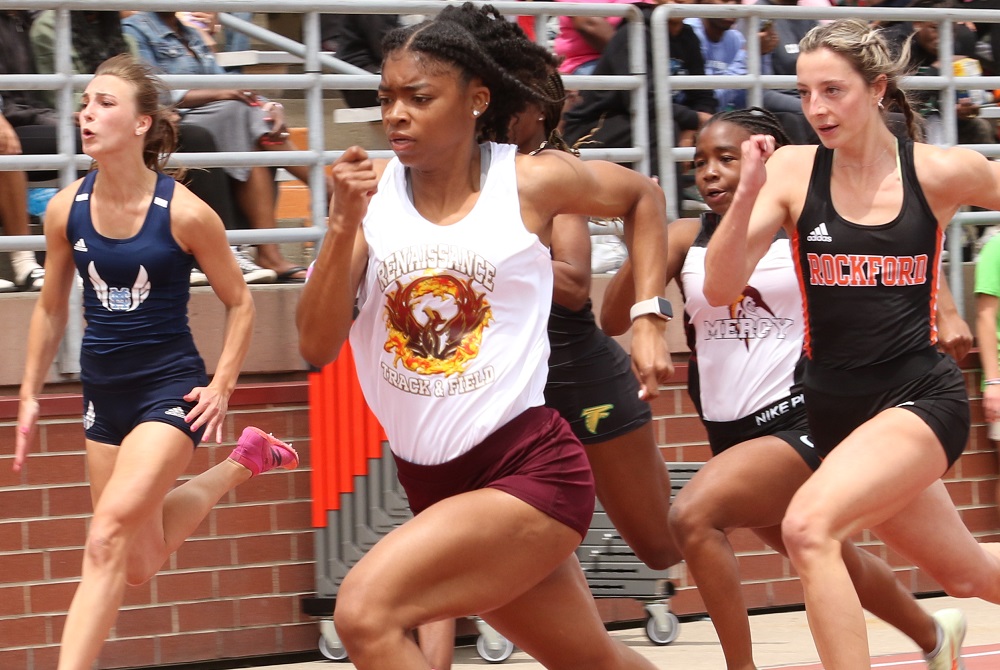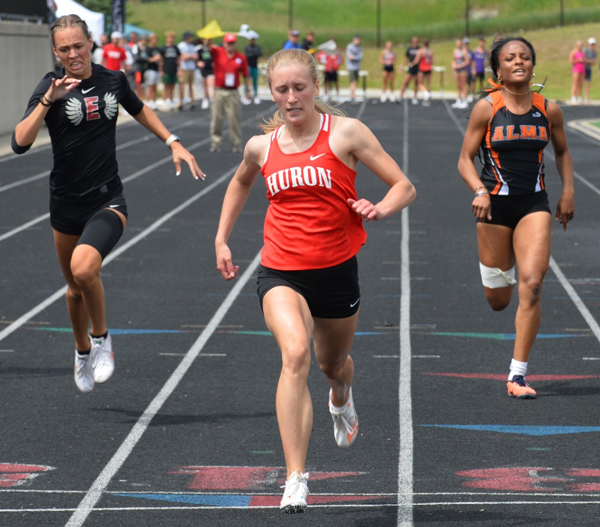
Renaissance Follows Record-Setting Jackson to 1st Division 1 Finals Win
By
Paul Costanzo
Special for MHSAA.com
June 4, 2022
ROCKFORD – Before she even ran a race Saturday, Kaila Jackson had already established herself as one of the best sprinters in MHSAA history.
But in her final meet, she gave everyone at the Lower Peninsula Division 1 Track & Field Finals one final show.
The Detroit Renaissance senior won four Finals titles Saturday, repeating the feat she had accomplished in 2021, and led the Phoenix to their first Division 1 team title.
“The question was asked early in the season if I thought Kaila was one of the all-time great sprinters,” Renaissance co-coach Calvin Johnson said. “She solidified her legacy today. She solidified her legacy. With her going down to Georgia now to be a Bulldog, there’s nothing I can say but they’re getting a great athlete – a great student-athlete. It’s unfortunate they don’t have an MVP trophy, because she should get it, hands down.”
Jackson was responsible for 40 of Renaissance’s 80 points on the day. Three-time reigning champion Oak Park was second with 60. Ann Arbor Huron (55), Holland West Ottawa (47) and Ann Arbor Pioneer (38) rounded out the top five.
It was the first Finals title for Renaissance since 2007, when it finished a run of 10 Division 2/Class B titles over 11 seasons. The Phoenix were runners-up to Oak Park both of the past two seasons.
“It’s well overdue,” Renaissance co-coach Darnell Hall said. “It’s a good honor to finally get that monkey off our back. Especially with a good group of girls, the elite kids we have, this was the last thing they needed to solidify their legacy in the state of Michigan, was that Michigan state title.”
Jackson won the 100 meters and 200 meters and was part of the winning 400 and 800 relay teams. Olivia Jenkins, Madison Sheard and Jayla Graham joined Jackson on the 400 relay, while Jenkins, Chloe Vines and Jayla Dace joined her on the 800 relay.
Jackson’s winning 200-meter time of 23.51 seconds broke the all-Finals record of 23.74 run by Shayla Mahan of Detroit Mumford in 2006.
 “It feels amazing to break a state record,” Jackson said. “I knew it was going to come, but I’m happy it came now. I worked very hard for this. I just feel so accomplished.”
“It feels amazing to break a state record,” Jackson said. “I knew it was going to come, but I’m happy it came now. I worked very hard for this. I just feel so accomplished.”
She won the 100 in 11.64, and the relays came in at 47.01 and 1:38.09, respectively.
“I really work hard for this,” Jackson said. “Everything paid off, all the hard practices, the crying, smiling, it’s paid off. I’ve worked very hard.”
The Phoenix also got a Finals title from Leeah Burr, who won the 400 in 55.05.
Oak Park had three champions on the day, led by Morgan Roundtree’s record-breaking performance in the 300 hurdles. Roundtree’s time of 42.38 broke the LP Division 1 Finals record of 42.64 set by Wyandotte Roosevelt’s Kyana Evans in 2017. Ann Arbor Huron’s Mya Georgiadis was second in the race at 42.52, also breaking the record.
Nonah Waldron won the 100 hurdles for Oak Park in 13.9 seconds, while Drelin Mapp won the long jump with a distance of 18 feet, 2.25 inches.
Two others joined Jackson in winning multiple individual titles on the day.
Allen Park’s Abigail Russell won the discus and the shot put. Her throw of 144-4 in the discus won by nearly seven feet, while her throw of 41-8.25 in the shot put won by eight inches.
Traverse City Central’s Julia Flynn pulled off the 1,600/800 double, and even came back and placed fifth in the 3,200.
She won the 1,600 in 4:39.75, and the 800 in 2:08. In the 800, she took control of the race about 250 meters in, and never relinquished her lead.
“I wanted to go out in my first lap, not crazy, crazy, crazy fast,” Flynn said. “I let myself ease into the competition a little bit, had girls in front of me. Then, I had the fear of getting boxed in, so then I just peaced out. I was trying to use my competition, I wanted to stay with them a little longer than I did, but I started to get in that inner lane, and I was like, ‘I don’t want to misstep and get DQ’d.”
Dexter’s Sophia Mettes repeated as champion in the pole vault, clearing 13 feet to hold off a tough field.
“Coming into this I was a little nervous, because I knew I had really good competition,” Mettes said. “Natalie Blake (Holland West Ottawa), I’m competing with her next year (at Michigan State), so I’m super excited. She’s been looking so strong. Brooke Bowers (Grand Rapids Forest Hills Central), she’s been looking great, too. I knew I had a lot to look up to, and I was feeling a little tired coming in, but it was a great competition. I just got nervous throughout the whole thing, but my adrenaline kept me going.”
Holland West Ottawa’s Arianne Olson, who was runner-up to Flynn in the 1,600, won the 3,200 by more than 10 seconds, finishing in 10:23.43.
Ann Arbor Pioneer won the 3,200 relay in 8:55.58 with the team of Sylvia Sanok Dufallo, Emily Cooper, Cookie Baugh and Sarah Forsyth.
Ann Arbor Huron won the 1,600 relay in 3:52.81 with the team of Mackenzie Robinson, Jada Wilson, Christabelle Obi and Georgiadis.
Pioneer’s Gabriella Newman won the high jump with a jump of 5-8.
PHOTOS (Top) Detroit Renaissance's Kaila Jackson, front, powers to a win during Saturday's Lower Peninsula Division 1 Finals. (Middle) Traverse City Central's Julia Flynn turns into the straightaway during one of her races. (Click for more from John Brabbs/Run Michigan.)

Multi-Sprint Champ Racing to Finish Huron Career Ahead of the Rest Again
By
Keith Dunlap
Special for MHSAA.com
May 25, 2023
NEW BOSTON – If there was one thing Elizabeth Anderson took pride in elementary school, it was simply showing that she could outrun everyone in sight.
 In fact, Anderson has an explanation for all the success she had in those playground races.
In fact, Anderson has an explanation for all the success she had in those playground races.
“Dominance when you are in elementary school,” Anderson quipped. “I don’t think I ever had a nickname. I just think everyone knew I was fast.”
Years later, pretty much everyone who follows track & field in the state of Michigan can attest to that.
A senior for New Boston Huron, Anderson has been faster than most other competitors in the state during her three-year high school career (with her freshman season in 2020 canceled due to COVID-19).
Last year, Anderson won titles at the Lower Peninsula Division 2 Finals in the 200-meter (25.07) and 400-meter (56.28) dashes, and was runner-up in the 100-meter dash (12.23).
Often, top sprinters focus on one or two of those three races. But Anderson is certainly a different breed of sprinter because she does all three.
In fact, she holds school records in all three of those events, and if all that weren’t enough, Anderson is a part of all three sprint relay teams.
“It is hard to give her events off,” said New Boston Huron head girls track coach Danielle Lobato.
Despite the different styles the 100, 200 and 400-meter dashes present, Anderson said there usually isn’t much adjusting when she goes from one of those races to another.
 The strategy is simply, “Let’s beat the other girls to the finish line.”
The strategy is simply, “Let’s beat the other girls to the finish line.”
“I don’t really go into each race changing up how I would run,” she said.
While enjoying and succeeding in all three races, Anderson said she actually does have a favorite among them.
“I would say the 400 is probably my favorite,” she said. “Even though it hurts, it’s satisfying to see how much you can get your time down in the 400 compared to any other race.”
Anderson said she started running track in sixth grade, but really got serious about it during the summer after her sophomore season, when she was invited to run for a local club.
Eventually, that led to her competing over the winter in indoor events.
She lived and breathed track so much that last fall, she decided to not run cross country so she could focus on a weightlifting regimen aimed at developing more leg strength.
“Once I started doing summer track, I realized I wanted to be doing this all the time,” she said.
Lobato said oftentimes in practice, Anderson is a de facto coach, given there is no better person she can think of for the younger runners on the team to learn from.
“I can’t always demonstrate these things I’m trying to teach,” she said. “You get to see it in real life (from Anderson), not in a YouTube video.”
After winning the 100, 200 and 400-meter dashes at her Regional meet last week, Anderson has her sights set on achieving the same trifecta of titles at next Saturday’s Finals in Grand Rapids.
Anderson has signed to run track at Michigan State, but has been plenty motivated to keep producing this spring in her final high school season.
“I’m really looking to defend my titles,” she said. “That is what is really motivating me to keep going. I want to keep in shape for the college season. I don’t want to lose any of the progress I have made. Ultimately, I just love running track.”
And since elementary school, Anderson has loved — and succeeded in — outrunning everyone else to the finish line.
“We knew we were getting something special,” Lobato said of when Anderson arrived in high school. “But you never expect this. All that she has accomplished is amazing.”
 Keith Dunlap has served in Detroit-area sports media for more than two decades, including as a sportswriter at the Oakland Press from 2001-16 primarily covering high school sports but also college and professional teams. His bylines also have appeared in USA Today, the Washington Post, the Detroit Free Press, the Houston Chronicle and the Boston Globe. He served as the administrator for the Oakland Activities Association’s website from 2017-2020. Contact him at [email protected] with story ideas for Oakland, Macomb and Wayne counties
Keith Dunlap has served in Detroit-area sports media for more than two decades, including as a sportswriter at the Oakland Press from 2001-16 primarily covering high school sports but also college and professional teams. His bylines also have appeared in USA Today, the Washington Post, the Detroit Free Press, the Houston Chronicle and the Boston Globe. He served as the administrator for the Oakland Activities Association’s website from 2017-2020. Contact him at [email protected] with story ideas for Oakland, Macomb and Wayne counties
PHOTOS (Top) New Boston Huron's Elizabeth Anderson clears the finish line during last season's LPD2 400 race. (Middle) Anderson, middle, outpaces the field to also win the 200. (Click for more from RunMichigan.com.)

